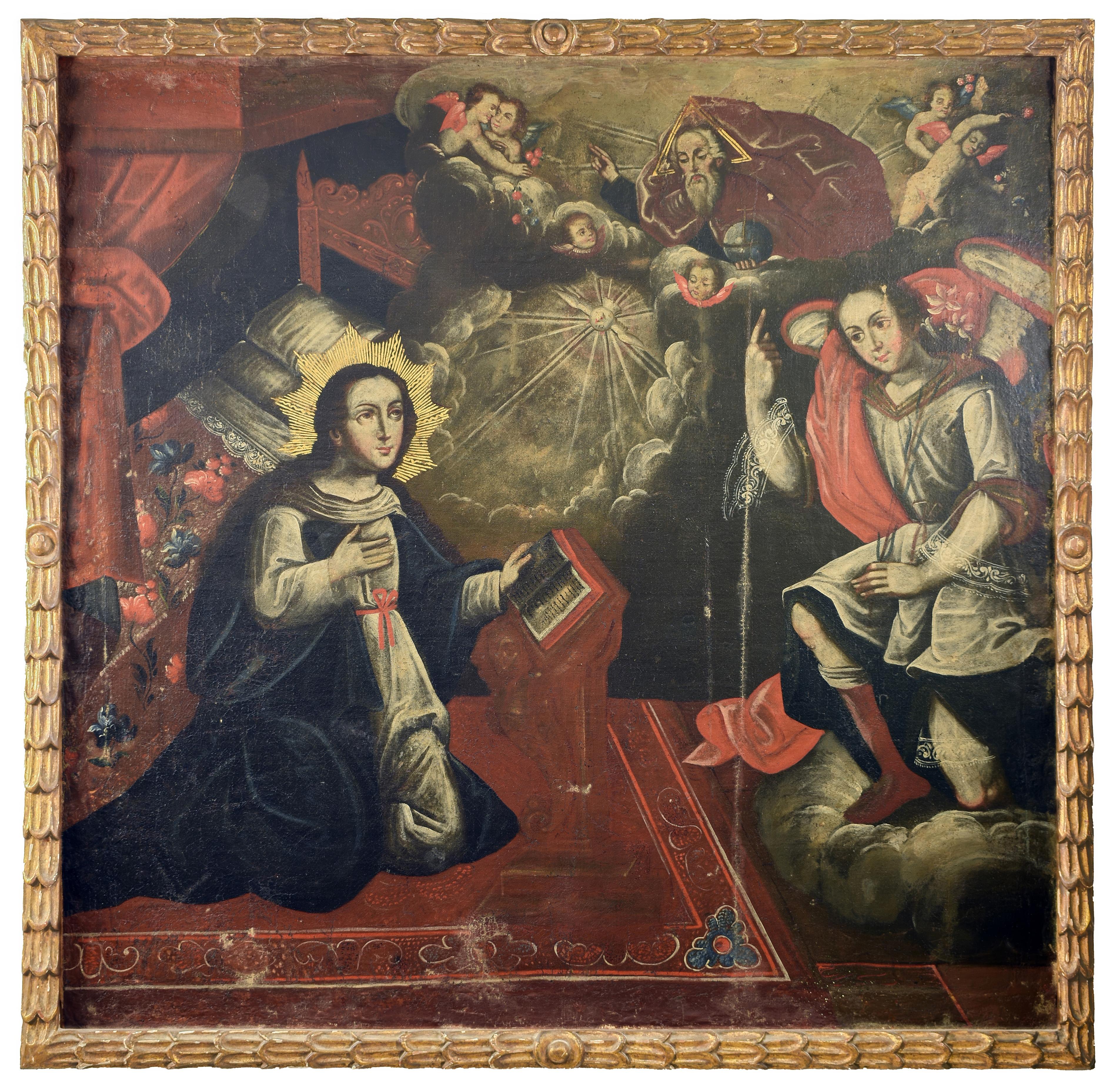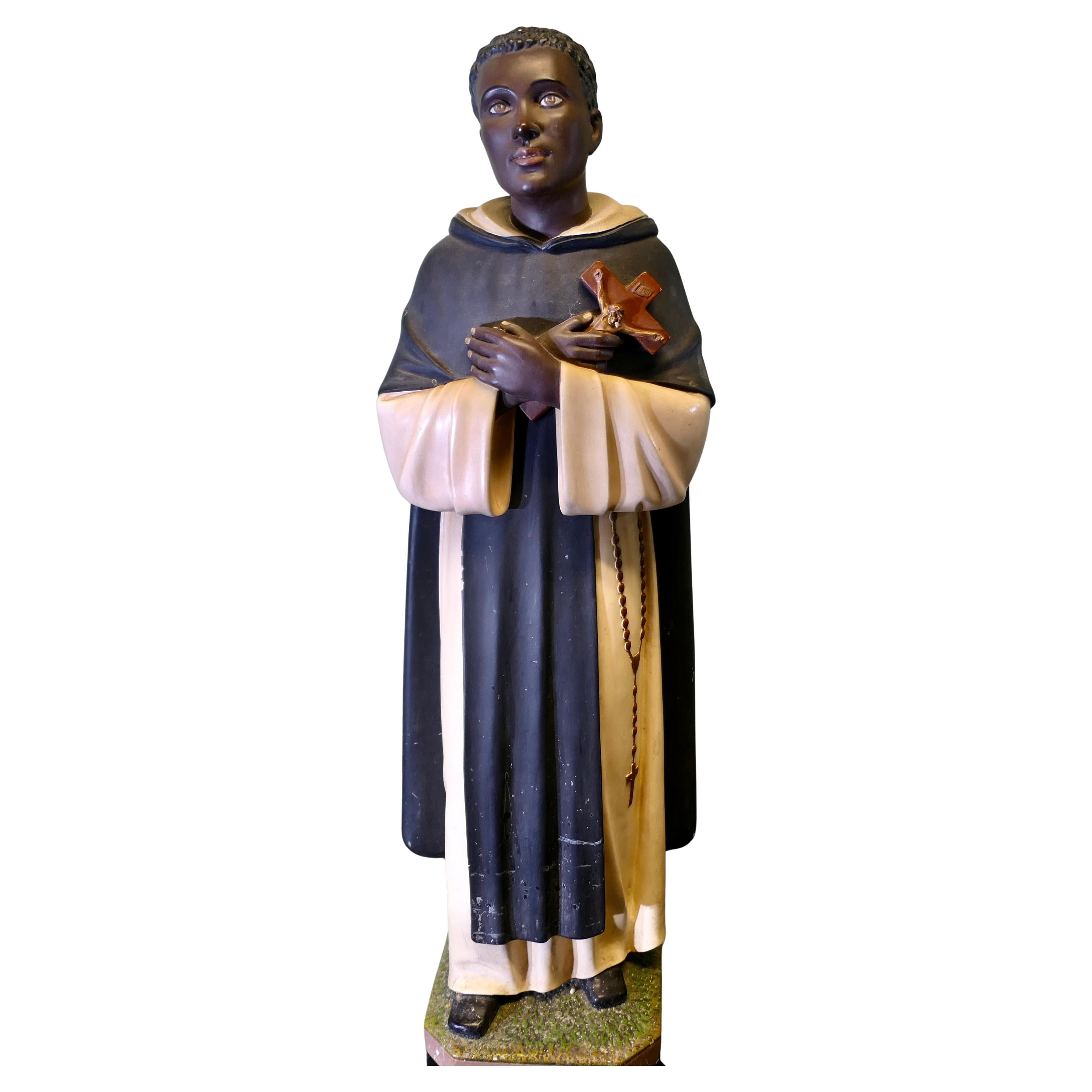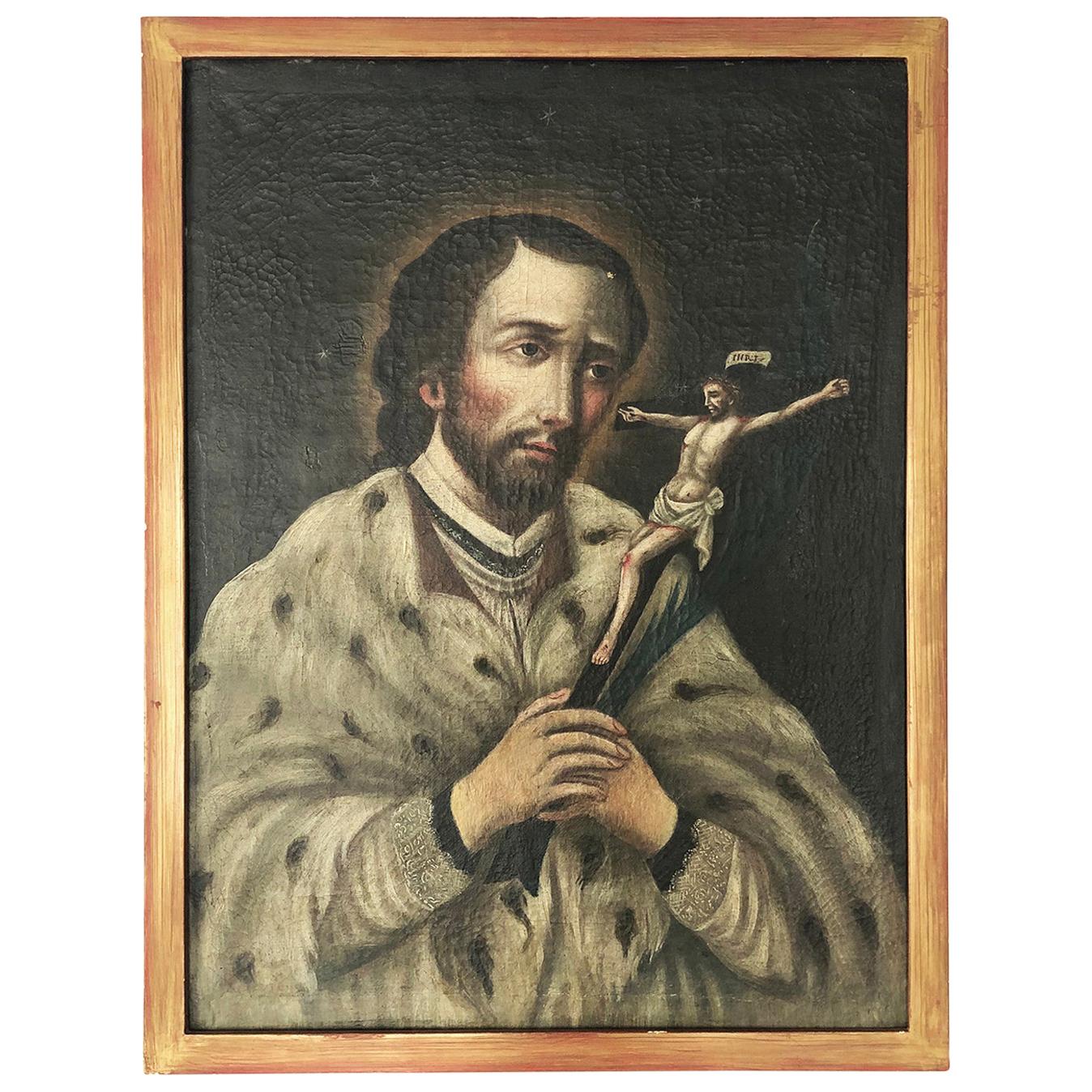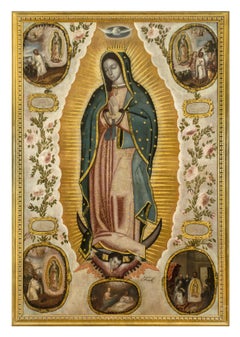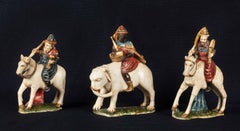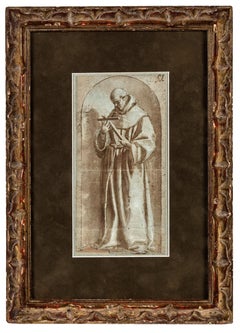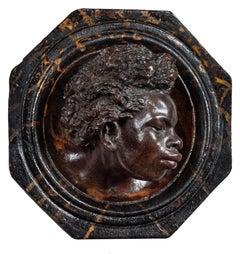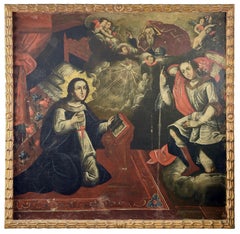Items Similar to Saint Martin de Porres
Want more images or videos?
Request additional images or videos from the seller
1 of 2
Peruvian School, 18th - 19th CenturySaint Martin de Porres
$17,250
£13,038.86
€14,983.97
CA$24,020.52
A$26,721.84
CHF 14,007.92
MX$326,534.40
NOK 178,373.45
SEK 167,913.92
DKK 111,849.66
Shipping
Retrieving quote...The 1stDibs Promise:
Authenticity Guarantee,
Money-Back Guarantee,
24-Hour Cancellation
About the Item
Provenance: Private Collection, New York, until 2022.
Martín de Porres was born in Lima in 1579, the illegitimate son of a Spanish-American father, Juan de Porras, and Ana Velázquez, a formerly enslaved woman of African descent from Panama. Abandoned by his father, Martín grew up in poverty. He was apprenticed to a barber-surgeon, but soon entered the Dominican Convent of El Rosario in Lima, first as a servant, then an almoner, and eventually a lay brother. While his ancestry prohibited his taking full orders, a life of profound devotion, care for the sick, and extreme acts of charity was accompanied by miracles that led to widespread popular veneration after his death in 1639, beatification in 1837, and canonization in 1962. Today Martín de Porres is the patron saint of mixed-race people, barbers, health workers, and those seeking racial harmony in the Catholic Church. He is also well known for his love of animals.
No contemporary portrait of Martín de Porres is known, but the earliest images of him from the late 17th century share the same iconographic features seen in this work, painted by an anonymous late 18th or 19th-century Peruvian artist. He is depicted as a young man wearing a Dominican habit, the black-and-white colors alluding as well to his mixed-race. The future saint has a halo reflecting popular veneration of him, and he is shown holding a broom—his traditional symbol, which reflected the menial work performed by a good part of the freed and enslaved Afro-Peruvians that then comprised nearly 50% of Lima’s population. He wears the rosary, to which his convent was dedicated, and carries a basket of bread, denoting saintly charity, both associated with the Dominican Order.
- Creator:Peruvian School, 18th - 19th Century (Peruvian)
- Dimensions:Height: 9 in (22.86 cm)Width: 6.62 in (16.82 cm)
- Medium:
- Period:
- Condition:
- Gallery Location:New York, NY
- Reference Number:1stDibs: LU10212419372
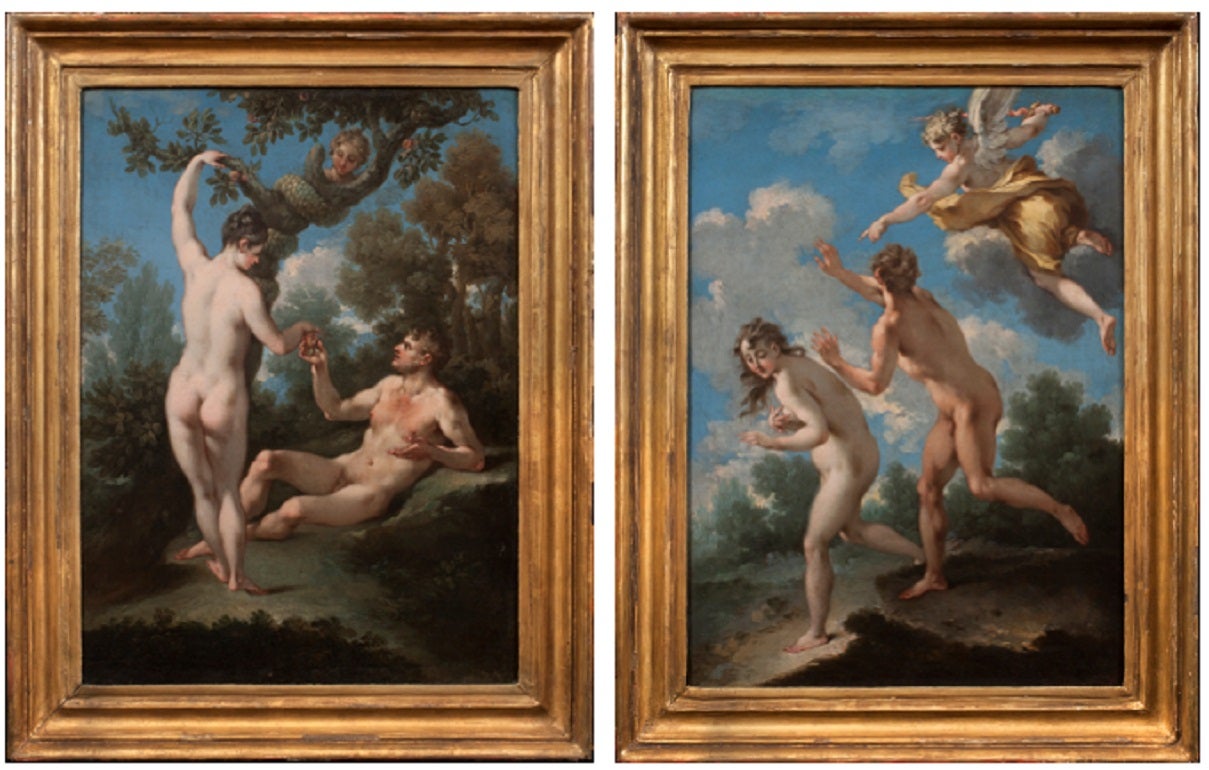
About the Seller
5.0
Recognized Seller
These prestigious sellers are industry leaders and represent the highest echelon for item quality and design.
Established in 1997
1stDibs seller since 2012
22 sales on 1stDibs
Typical response time: 5 hours
- ShippingRetrieving quote...Shipping from: New York, NY
- Return Policy
Authenticity Guarantee
In the unlikely event there’s an issue with an item’s authenticity, contact us within 1 year for a full refund. DetailsMoney-Back Guarantee
If your item is not as described, is damaged in transit, or does not arrive, contact us within 7 days for a full refund. Details24-Hour Cancellation
You have a 24-hour grace period in which to reconsider your purchase, with no questions asked.Vetted Professional Sellers
Our world-class sellers must adhere to strict standards for service and quality, maintaining the integrity of our listings.Price-Match Guarantee
If you find that a seller listed the same item for a lower price elsewhere, we’ll match it.Trusted Global Delivery
Our best-in-class carrier network provides specialized shipping options worldwide, including custom delivery.More From This Seller
View AllVirgin of Guadalupe
Located in New York, NY
Signed and dated, lower right, Joseph de la Cruz f.t / Año de 88.
Provenance: Private Collection, Santo Stefano d’Aveto (Genoa), ca. 1960–2022.
This monumental canvas is a rare, signed example of one of the most popular subjects of Spanish Colonial, and particularly Mexican, painting: the Virgin of...
Category
Late 18th Century Paintings
Materials
Canvas, Oil
The Three Magi
Located in New York, NY
Provenance: Private Collection, Spain.
Known as Peruvian alabaster for its translucency and workability, Piedra de Huamanga is a highly prized material from the province of Ayacucho in Peru. In the 17th and 18th centuries, local craftsman in the town of Huamanga began to specialize in the production of small-scale, polychrome religious sculptures made from this distinctive stone. Huamanga sculptures are among the most accomplished examples of carving from the Spanish Americas, where polychrome wood sculpture was a far more common sculptural medium. These works, which were created as independent sculptures or as sculptural groups—such as our three Magi—were intended for ecclesiastical as well as domestics settings.
Our three figures likely formed part of a larger Nativity group—a New World variant of the tradition of the Neapolitan Crèche...
Category
Late 18th Century Figurative Sculptures
Materials
Alabaster
Study of a Franciscan Saint, probably San Diego de Alcalá
Located in New York, NY
Provenance: Ivan E. Phillips, Montreal and New York, until 2023.
The brothers Bartolomé Carducho and Vicente Carducho, both born and trained in Florence, settled in Spain where they made their careers. Vicente worked on numerous commissions for both the church and the Spanish court...
Category
17th Century Old Masters Drawings and Watercolor Paintings
Materials
Paper, Chalk, Ink, Pen
Head of a Young African Man
Located in New York, NY
Provenance: Private Collection, Spain.
This intriguing and enigmatic sculpture depicts the head of a young African man emerging from a circular opening ...
Category
Early 1800s Figurative Sculptures
Materials
Terracotta
View of St. John’s Cathedral, Antigua
Located in New York, NY
Provenance:
Robert Hollberton, Antigua, ca. 1841
Private Collection, New York
The present painting depicts Old St. John’s Cathedral on the island of Antigua. The church was erected in the 1720s on the designs of the architect Robert Cullen. It measured 130 feet by 50 feet with north and south porches 23 x 20 ½ feet. The tower, 50 feet high with its cupola, was added in 1789. The church was elevated to the status of a cathedral, but disaster struck in the form of an earthquake that destroyed the building on 8 February 1843. A memorandum of that date relates the event:
“On Wednesday, 8th February, 1843, this island was visited by a most terrific and destructive earthquake. At twenty minutes before eleven o’clock in the forenoon, while the bell was ringing for prayers, and the venerable Robert Holberton was in the vestry-room, awaiting the arrival of persons to have their marriage solemnized, before the commencement of the morning service, the whole edifice, from one end to the other, was suddenly and violently agitated. Every one within the church, after the first shock, was compelled to escape for his life. The tower was rent from the top to the bottom; the north dial of the clock precipitated to the ground with a dreadful crash; the east parapet wall of the tower thrown upon the roof of the church; almost the whole of the north-west wall by the north gallery fell out in a mass; the north-east wall was protruded beyond the perpendicular; the altar-piece, the public monument erected to the memory of lord Lavington, and the private monuments, hearing the names of Kelsick, Warner, Otley, and Atkinson, fell down piecemeal inside; a large portion of the top of the east wall fell, and the whole of the south-east wall was precipitated into the churchyard, carrying along with it two of the cast-iron windows, while the other six remained projecting from the walls in which they had been originally inserted; a large pile of heavy cut stones and masses of brick fell down at the south and at the north doors; seven of the large frontpipes of the organ were thrown out by the violence of the shock, and many of the metal and wooden pipes within displaced; the massive basin of the font was tossed from the pedestal on which it rested, and pitched upon the pavement beneath uninjured. Thus, within the space of three minutes, this church was reduced to a pile of crumbling ruins; the walls that were left standing being rent in every part, the main roof only remaining sound, being supported by the hard wood pillars.”
The entrance from the southern side into the cathedral, which was erected in 1789, included two imposing statues, one of Saint John the Divine and the other of Saint John the Baptist in flowing robes. It is said that these statues were confiscated by the British Navy from the French ship HMS Temple in Martinique waters in 1756 during the Seven Years’ War and moved to the church. The statues are still in situ and can be seen today, much as they appeared in Bisbee’s painting, but with the new cathedral in the background (Fig. 1).
Little is known of the career of Ezra Bisbee. He was born in Sag Harbor, New York in 1808 and appears to have had a career as a political cartoonist and a printmaker. His handsome Portrait of President Andrew Jackson is dated 1833, and several political lithographs...
Category
19th Century Old Masters Landscape Paintings
Materials
Canvas, Oil
St. Vincent Ferrer Preaching to the People of Salamanca
Located in New York, NY
Provenance:
Private Collection, New Jersey
The present painting depicts Saint Vincent Ferrer preaching from a raised pulpit to a group of seven peopl...
Category
15th Century and Earlier Renaissance Figurative Paintings
Materials
Oil, Wood Panel
You May Also Like
Latin American Colonial Cuzco School 18th Century Annunciation
Located in New York, NY
18 Century Cuzco School oil on canvas of the Annunciation. Good condition. Unsigned.
Category
18th Century Figurative Paintings
Materials
Oil, Canvas
A Statue of Saint Martín de Porres Velázquez OP A Statue of Saint Martín
Located in Godshill, Isle of Wight
A Statue of Saint Martín de Porres Velázquez OP
A Statue of Saint Martín de Porres Velázquez OP was a Peruvian lay brother of the Dominican Order who was beatified in 1837 by Pope G...
Category
Vintage 1930s Folk Art Sculptures and Carvings
Materials
Plaster
Fray Antonio de San Pedro by Manuel de Arellano, XVII Century
By Manuel de Arellano
Located in Mexico, DF
XVII century Mexican Painting by Arellano. "EL BENERABLE SIERVO D DIOS Fray Antonio de S. Pedro de la Sagrada Religion N. S. de la Merced"
Signed: Arellano fecit
Category
Antique 17th Century North American Spanish Colonial Paintings
Materials
Canvas
Our Lady of Solitude, Spanish Colonial School, 18th Century
Located in DEVENTER, NL
Spanish Colonial School, 18th Century
Our Lady of Solitude
Oil on canvas
In antique gilt frame
Dimensions excl. frame: 92 x 72 cm.
Dimensions incl. frame: 124 x 103.5 cm.
Overall i...
Category
18th Century Figurative Paintings
Materials
Canvas, Oil
19th Original Mexican Oil on Canvas of San Juan Nepomuceno
Located in Mexico City, CDMX
We offer this 19th original Mexican oil on canvas of San Juan Nepomuceno.
About John of Nepomuk:
Is the saint of Bohemia (Czech Republic) who...
Category
Antique Late 19th Century Mexican Folk Art Religious Items
Materials
Canvas
$1,750 Sale Price
50% Off
Latin American Colonial Cuzco School Christ at the column
Located in New York, NY
Cuzco School oil on canvas laid on panel. 18th Century. Unsigned.
Category
18th Century Figurative Paintings
Materials
Canvas, Oil
More Ways To Browse
Woman Carrying Basket
18th Century Spanish Portrait
Antique Rosaries
Antique Rosary Rosaries
Antique Broom
Antique African Baskets
18th Century Antique Rosary
Vintage Academy Awards
Large Green Painting
Large Period Painting
Oil Painting By Artist Fields
Abstract Dream Painting
Painting Of Knife
Sacred Art
20th Century British Painting
Spanish Modern Paintings
Circle Abstract Art
Yellow Portrait
